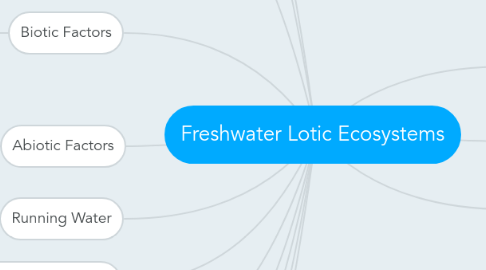Freshwater Lotic Ecosystems
von nick minio

1. Brooks
2. Springs
3. Lotic ecosystems always flow in one direction. Usually they start in the mountains, formed by snowmelt and rain, and they flow downward over the land. They typically last hundreds of thousands of years. Smaller ecosystems such as creeks may dry up each year as the seasons change. The types of organisms that live in lotic ecosystems depend on many things. Such as how fast the water is flowing, the amount of light, and the temperature. Organisms in lotic systems must be able to adapt to handle the high oxygen content, which is caused by the flowing water. Lotic systems have a low salt content. Animals must be able to prevent excess water from building up in their bodies. Algae and plants provide energy for animals in lotic ecosystems. Many invertebrates, such as insects, snails, and crayfish, depend on the flowing water to bring them oxygen and nutrients. Fish that live in lotic ecosystems must be adapted to survive in flowing water. Many lotic systems connect to each other and form a path to the ocean, so some fish species spend part of their lives in freshwater and part in the ocean. Other vertebrates spend part of the time on land and part in the water, such as species of amphibians, reptiles, mammals, and birds. Specific examples include: frogs, salamanders, snakes, turtles, beavers, and river otters.
4. Biotic Factors
4.1. Fish
4.2. Birds
4.3. Snakes
4.4. Insects
5. Abiotic Factors
5.1. Low Salt Content
5.2. High Oxygen Content
6. Running Water
7. Can last for thousands of years
8. High oxygen content due to flowing water
9. Low salt content
10. Nourished by melting snow and rain
11. Animals help to stabilize water level in bodies
12. Fish adapt to survive in flowing water
13. Rivers
13.1. Animals that live in rivers include fish, some insect larvae and reptiles, such as turtles. Mammals, such as river otters, beavers and muskrats, also live in rivers, as do amphibians, such as frogs and salamanders.
14. Streams
15. Creeks
15.1. Many types of animals live in creeks and it varies widely by where the creek is. Mostly you will find minnows, crawfish and tadpoles.


